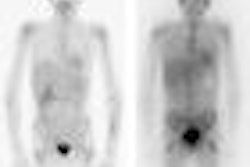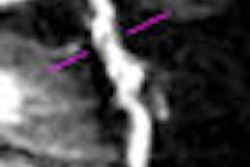Using a low-dose protocol and eliminating contrast from the CT portion of PET/CT studies resulted in only slightly lower sensitivity for detecting metastases in melanoma patients, while delivering less radiation and no exposure to potential contrast reactions, German researchers found.
The study, led by Dr. Thomas Pfluger from the University of Munich Department of Nuclear Medicine, included 50 PET/CT examinations on 38 patients with metastasized malignant melanoma. A total of 232 lesions were detected, with 151 proved to be metastases.
The evaluation criteria included evidence for viable tumor tissue based, in part, on tumor size and standardized uptake value. The gold standard for comparison was histology and patient follow-up over a minimum of six months.
The researchers reviewed five separate sets of images, three of which were single-modality acquisitions: low-dose noncontrast-enhanced CT, contrast-enhanced CT, and FDG-PET alone. They also analyzed two acquisitions with combined imaging modalities -- noncontrast-enhanced PET/CT and contrast-enhanced PET/CT -- Pfluger said in his presentation at the 2009 SNM annual meeting in Toronto.
The results showed greater sensitivity and specificity for PET alone and PET combined with both noncontrast-enhanced CT and contrast-enhanced CT. "As expected, we had the worst results from the plain CT that was used for attenuation correction, and there was an improvement, of course, with the administration of contrast agents," Pfluger said.
PET/CT for melanoma staging
|
||||||||||||||||||
| Source: Dr. Thomas Pfluger, University of Munich. |
The best results for the single-modality examinations were achieved with PET alone, while the combined imaging had a "marked increase" in sensitivity and specificity, especially with contrast-enhanced CT, Pfluger said.
False readings
In comparing the single-modality results, noncontrast-enhanced CT missed 28 lesions, with false negatives occurring in lymph node metastases (n = 19) and liver/spleen metastases (n = 9). Noncontrast-enhanced CT also produced 17 additional false positives, in physiological structures, compared to contrast-enhanced CT.
When comparing results between the combined PET/CT techniques, the nonenhanced protocol produced five false-negative results and six false positives, and the contrast-enhanced technique recorded no false negatives and six false positives. The false-positive findings on PET/CT did not change patient management, according to the study.
Modality limitations
When CT and PET were used on their own, the researchers noted limitations to both modalities. For example, CT has difficulty in determining lymph nodes and detecting bone marrow metastases.
"Additional limitations of noncontrast-enhanced CT were differentiation between vessels versus lymph nodes and the detection of soft-tissue metastases, especially in the liver," Pfluger said. "The limitations of FDG-PET alone were the detection of lung and liver metastases, and it was difficult to differentiate physiological changes with increased FDG uptake versus metastases."
The combination of PET and CT "markedly increased" sensitivity and specificity compared to single-modality examinations, Pfluger added.
Given the results, the researchers concluded that it is justified to perform noncontrast-enhanced CT with PET instead of contrast-enhanced CT with PET for staging malignant melanoma patients. Using PET with noncontrast-enhanced CT lowers the radiation exposure to patients and can shorten their scan times.
By Wayne Forrest
AuntMinnie.com staff writer
August 12, 2009
Related Reading
PET/CT beats 3T MRI in whole-body primary tumor staging, March 10, 2008
FDG-PET/CT aids in radiation therapy planning, March 5, 2008
False positives a concern with FDG-PET/CT for head, neck tumors, January 31, 2008
PET/CT shows its worth in cervical carcinoma, January 18, 2008
PET/CT moves closer to diagnostic standard of care, March 1, 2007
Copyright © 2009 AuntMinnie.com



















